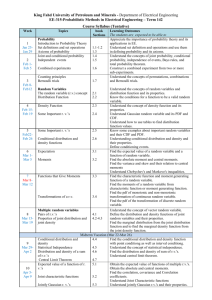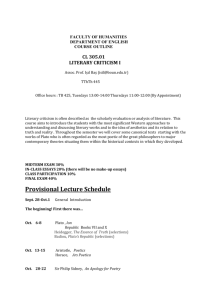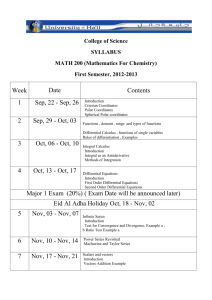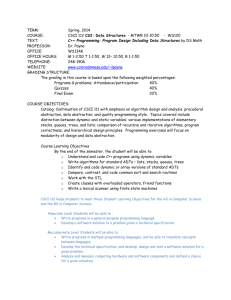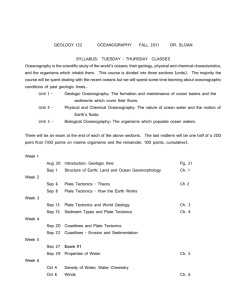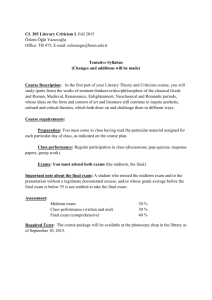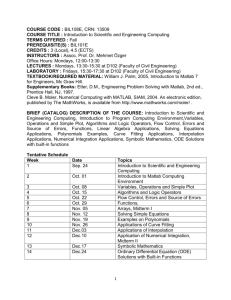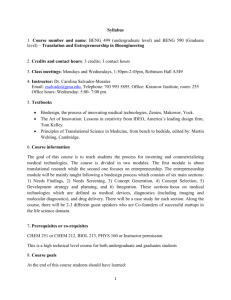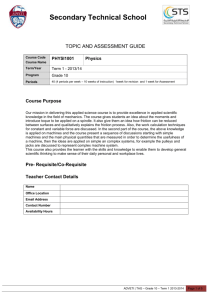Syllabus - King Fahd University of Petroleum and Minerals
advertisement
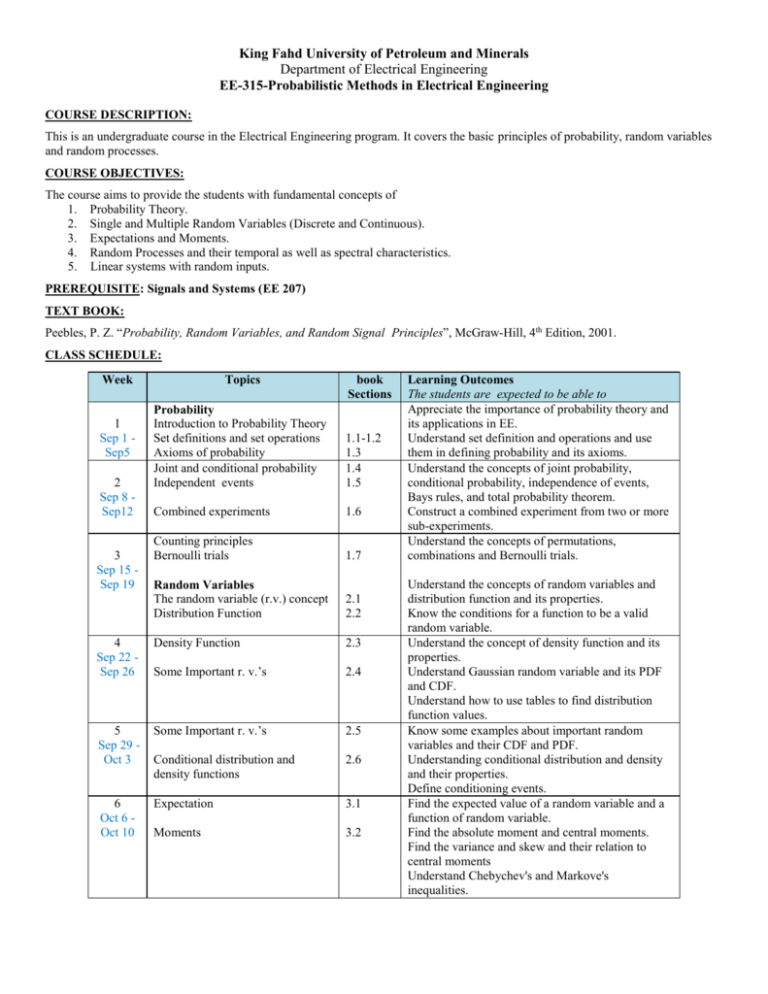
King Fahd University of Petroleum and Minerals Department of Electrical Engineering EE-315-Probabilistic Methods in Electrical Engineering COURSE DESCRIPTION: This is an undergraduate course in the Electrical Engineering program. It covers the basic principles of probability, random variables and random processes. COURSE OBJECTIVES: The course aims to provide the students with fundamental concepts of 1. Probability Theory. 2. Single and Multiple Random Variables (Discrete and Continuous). 3. Expectations and Moments. 4. Random Processes and their temporal as well as spectral characteristics. 5. Linear systems with random inputs. PREREQUISITE: Signals and Systems (EE 207) TEXT BOOK: Peebles, P. Z. “Probability, Random Variables, and Random Signal Principles”, McGraw-Hill, 4th Edition, 2001. CLASS SCHEDULE: Week Topics book Sections Probability Introduction to Probability Theory Set definitions and set operations Axioms of probability Joint and conditional probability Independent events 1.1-1.2 1.3 1.4 1.5 Combined experiments 1.6 Counting principles Bernoulli trials 1.7 Random Variables The random variable (r.v.) concept Distribution Function 2.1 2.2 4 Sep 22 Sep 26 Density Function 2.3 Some Important r. v.’s 2.4 5 Sep 29 Oct 3 Some Important r. v.’s 2.5 Conditional distribution and density functions 2.6 6 Oct 6 Oct 10 Expectation 3.1 Moments 3.2 1 Sep 1 Sep5 2 Sep 8 Sep12 3 Sep 15 Sep 19 Learning Outcomes The students are expected to be able to Appreciate the importance of probability theory and its applications in EE. Understand set definition and operations and use them in defining probability and its axioms. Understand the concepts of joint probability, conditional probability, independence of events, Bays rules, and total probability theorem. Construct a combined experiment from two or more sub-experiments. Understand the concepts of permutations, combinations and Bernoulli trials. Understand the concepts of random variables and distribution function and its properties. Know the conditions for a function to be a valid random variable. Understand the concept of density function and its properties. Understand Gaussian random variable and its PDF and CDF. Understand how to use tables to find distribution function values. Know some examples about important random variables and their CDF and PDF. Understanding conditional distribution and density and their properties. Define conditioning events. Find the expected value of a random variable and a function of random variable. Find the absolute moment and central moments. Find the variance and skew and their relation to central moments Understand Chebychev's and Markove's inequalities. 7 Oct 13 Oct 17 Functions that Give Moments 3.3 Transformations of a r.v. 3.4 Oct 20 Oct 31 8 Nov 3 Nov 7 9 Nov 10 Nov 14 10 Nov 17 Nov 21 11 Nov 24 Nov 28 12 Dec 1 Dec 5 13 Dec 8 Dec 12 14 Dec 15 Dec 19 15 Dec 22 Dec 26 Find the characteristic function and moment generating function of a random variable. Find the moments of a random variable from characteristic function or moment generating function. Find the pdf of monotonic and non-monotonic transformation of continuous random variable. Find the pdf of the transformation of discrete random variable. EID Al-Adha Vacation Multiple random variables Pairs of r.v.’s Properties of joint distribution and joint density 4.1 4.2-4.3 Conditional distribution and density Statistical Independence Distribution and density of a sum of r.v.’s Central Limit Theorem Expected value of a function of r. v.’s 4.4 Jointly Gaussian r. v.’s 5.3 Transformations of multiple r.v.’s 5.4 Linear transformations of Gaussian r.v.’s Sampling and some limit theorems 5.5 Random Processes –Temporal Characteristics Concept of a random process Stationary and independence Correlation functions and their properties Gaussian random process Poisson random process Random Processes – Spectral Characteristic Power Spectral Density and its properties Relationship between PSD and autocorrelation function Linear systems with random inputs Random signal response of linear systems Spectral characteristics of system response 4.5 4.6 4.7 5.1 5.7 6.1 6.2 6.3-6.4 6.5 6.6 7.1 7.2 8.2-8.3 8-4 Understand the concept of vector random variable. Define the distribution and density functions of joint random variables and their properties. Find the marginal distribution from the joint distribution function and to find the marginal density function from the joint density function. Find the conditional distribution and density function with point conditiong as well as interval conditiong. Understand the concept of statistical independence. Find the distribution and density of sum of r.v.'s. Understand central limit theorem. Obtain the expected value of functions of multiple r.v.'s. Obtain the absolute and central moments. Find the correlation, covariance and Correlation coefficients. Understand jointly Gaussian r.v.'s and their properties. Derive the density function of transformation of multiple r.v.'s. Perform a linear transformation of a set of Gaussian r.v.'s. Find the sample mean and variance. Understand the weak and strong laws of large numbers Understand the concept of random processes. Know different classes of r.p.'s Understand the concepts of stationary and independence of r.p.'s. Find the auto-correlation, auto-covariance, crosscorrelation and cross-covariance functions of r.p.'s. Understand Gaussian r.p. Understand Poisson r.p. Understand the concept of power density spectrum and its properties. Find RMS bandwidth of a r.p. Understand the relationship between PSD and autocorrelation function. Analyze LTI systems with random input in time and frequency domains. Evaluate system response and its mean, meansquared and auto-correlation values. Evaluate power spectral density of LTI system response. REVIEW REFERENCES: Leon-Garcia, A. “Probability and Random Processes for EE”, Addison Wesley, 2nd Edition, 1994. Ross, S. . “A First Course in Probability”, Prentice Hall, Fifth Edition, 1998. Helstrom, C.W. “Probability and Stochastic Processes for Engineers”, Addison-Wesley, 2nd Edition, 1992. Walpole, R.E., Myers, R.H. and Myers, S. L., “Probability and Statistics for Engineers and Scientists”, Prentice Hall, Sixth Edition, 1998. ASSESMENT: Quizzes 12% Class work 30% Assignments 8% Project 10% Major 1 15% Exams 70% Major 2 20% Final 35% Major 1: Saturday, Week 7, October 13, 2012, 6:00-8:00 PM (Coverage up to and including Section 2.6). Major 2: Wednesday, Week 12, December 5, 2012, 6:00-8:00 PM (Coverage up to and including Section 5.7). Final: Thursday, January 10, 2012, 7:00-10:00 PM (Comprehensive). Major exams and the final will be coordinated. Students should make sure that they understand all the material in all selected sections from the course textbook. INSTRUCTORS: Section 1 2 3 Timing SMW 9:00 SMW 13:10 SMW 10:00 Class in B59 2023 1015 2013 Instructor Dr. Wail Mousa Dr. Saad Al-Ahmadi Dr. Saad Al-Abeedi (Coordinator) OFFICE HOURS: SMW 11:00 - 11:40AM Office Loc. 59-2067 59-1066 59-0075 Tel 7759 7833 e-mail wailmousa saadbd alabeedi
